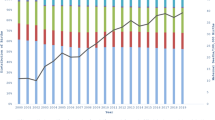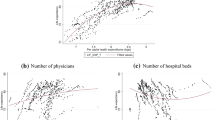Abstract
Mexico’s rapid increase in Cesarean section (C-section) births in the past 20 years parallels a trend occurring in other low- and middle-income countries across the globe, exceeding what is considered medically necessary. Although existing research has highlighted how social forces shape the role of “demand” factors related to women’s preference for C-section births and “supply” factors in health care settings where women give birth, it does not differentiate these births according to whether they were planned earlier in pregnancy or emergency C-sections initiated while a woman was in labor. The objective of this study is to assess the socioeconomic determinants of planned and emergency C-section births. In this study, we use nationally representative data from the 2014 Encuesta Nacional de la Dinámica Demográfica (ENADID) to examine determinants of planned and emergency C-section births for women who experienced their first birth within the past 5 years (N = 8710). Logistic regression analysis is employed to examine predictors of planned and emergency C-section births separately. Of the births in our sample, 49.2% were vaginal, 18.5% were planned C-sections, and 32.4% were emergency C-sections. We find that wealth and birth location are significant predictors of planned, but not emergency C-sections. Socioeconomic factors are important determinants of planned C-section births and represent a pathway through which social influence should be examined in the future when looking at the adaptation of surgical births in populations and health care system efforts to reduce the C-section rate.
Similar content being viewed by others
Notes
The analytic sample with emergency C-sections as the dependent variable (n = 7101) includes emergency C-section births (n = 2819) and vaginal births (n = 4282). The analytic sample with planned C-sections as the dependent variable (n = 5891) includes planned C-section births (n = 1609) and vaginal births (n = 4282)
References
Suárez-López L, Campero L, EDl V-S, Rivera-Rivera L, Hernández-Serrato MI, Walker D, et al. Características sociodemográficas y reproductivas asociadas con el aumento de cesáreas en México. Salud Publica Mex. 2013;55:S225–S34.
Guendelman S, Gemmill A, Thornton D, Walker D, Harvey M, Walsh J, et al. Prevalence, disparities, and determinants of primary Cesarean births among first-time mothers in Mexico. Health Aff. 2017;36(4):714–22.
Boerma T, Ronsmans C, Melesse DY, Barros AJ, Barros FC, Juan L, et al. Global epidemiology of use of and disparities in caesarean sections. Lancet. 2018;392(10155):1341–8.
World Health Organization. Infant and Young Child Fact Sheet. 2018. https://www.who.int/en/news-room/fact-sheets/detail/infant-and-young-child-feeding. Accessed November 8 2018.
Gibbons L, Belizán JM, Lauer JA, Betrán AP, Merialdi M, Althabe F. The global numbers and costs of additionally needed and unnecessary caesarean sections performed per year: overuse as a barrier to universal coverage. Geneva, Switzerland: World Health Organization; 2010.
Molina G, Weiser TG, Lipsitz SR, Esquivel MM, Uribe-Leitz T, Azad T, et al. Relationship between cesarean delivery rate and maternal and neonatal mortality. Jama. 2015;314(21):2263–70.
Villar J, Carroli G, Zavaleta N, Donner A, Wojdyla D, Faundes A, et al. Maternal and neonatal individual risks and benefits associated with caesarean delivery: multicentre prospective study.(Clinical report). Br Med J. 2007;335(7628):1025. https://doi.org/10.1136/bmj.39363.706956.55.
Patel RR, Peters TJ, Murphy DJ. Prenatal risk factors for caesarean section. Analyses of the ALSPAC cohort of 12 944 women in England. Int J Epidemiol. 2005;34(2):353–67.
Copelli FHS, Rocha L, Zampieri MFM, Gregório VRP, Custódio ZAO. Determinants of women’s preference for cesarean section. Texto Contexto-Enfermagem. 2015;24(2):336–43.
Belizán JM, Althabe F, Barros FC, Alexander S. Rates and implications of caesarean sections in Latin America: ecological study. BMJ (Clin Res Ed). 1999;319(7222):1397–400.
Aranda-Neri JC, Suárez-López L, DeMaria LM, Walker D. Indications for cesarean delivery in Mexico: evaluation of appropriate use and justification. Birth. 2017;44(1):78–85.
Potter JE, Hopkins K. Fau ́ndes A, Perpe ́tuo I. Women’s Autonomy and scheduled Cesarean sections in Brazil: a cautionary tale. Birth. 2008;35(1):33–40.
Soto-Vega E, Urrutia-Osorio M, Arellano-Valdez F, López I, Hernández H. The epidemic of the Cesarean section in private hospital in Puebla, México. Obstet Gynecol Int J. 2015;2(6):00058.
Heredia-Pi I, Servan-Mori EE, Wirtz VJ, Avila-Burgos L, Lozano R. Obstetric care and method of delivery in Mexico: results from the 2012 National Health and Nutrition Survey. PLoS One. 2014;9(8):e104166.
McCourt C, Weaver J, Statham H, Beake S, Gamble J, Creedy DK. Elective cesarean section and decision making: a critical review of the literature. Birth. 2007;34(1):65–79.
Guazo D. México: Una epidemia llamada cesárea. Fundación MEPI 2014. p. https://es.globalvoices.org/2014/10/02/mexico-una-epidemia-llamada-cesarea/. Accessed 15 Jan 2020
Barber SL. Mexico’s conditional cash transfer programme increases cesarean section rates among the rural poor. Eur J Pub Health. 2009;20(4):383–8.
Puentes-Rosas E, Gómez-Dantés O, Garrido-Latorre FJSM. Caesarean sections in Mexico: tendencies, levels and associated factors. Salud Publica Mex. 2004;46(1):16–22.
Gonzalez-Perez GJ, Vega-Lopez MG, Cabrera-Pivaral C, Muñoz A, Valle A. Caesarean sections in Mexico: are there too many? J Health Pol Syst Res. 2001;16(1):62–7.
Aguirre R, Antón J-I, Triunfo P. Análisis de las cesáreas en Uruguay por tipo de centro hospitalario. GACETA Sanitaria. 2018.
Eufrásio LS, Souza DE, Fonsêca AMC, Viana ESR. Brazilian regional differences and factors associated with the prevalence of cesarean sections. Fisioterapia em Movimento. 2018;31.
Esquivel G, Cruces G. The dynamics of income inequality in Mexico since NAFTA [with Comment]. Economía. 2011;12(1):155–88.
Canedo AP, Angel JL. Aging and the hidden costs of going home to mexico. J Cross Cult Gerontol. 2019;34(4):417–37. https://doi.org/10.1007/s10823-019-09379-3.
Han L, Saavedra-Avendano B, Lambert W, Fu R, Rodriguez MI, Edelman A, et al. Emergency contraception in Mexico: trends in knowledge and ever-use 2006-2014. Matern Child Health J. 2017;21(11):2132–9. https://doi.org/10.1007/s10995-017-2328-6.
Puig A, Pagán JA, Wong R. Assessing quality across healthcare subsystems in Mexico. J Ambul Care Manag. 2009;32(2):123–31. https://doi.org/10.1097/JAC.0b013e31819942e5.
Link BG, Phelan J. Social conditions as fundamental causes of disease. J Health Soc Behav. 1995;35:80–94.
Vallejos Parás A, Espino y Sosa S, Jaimes Betancourt L, Zepeda Tena C, Cabrera Gaytán DA, Arriaga Nieto L, et al. Obstetrician’s attitudes about delivery through cesarean section: a study in hospitals at Mexico City. Perinatología y Reproducción Humana. 2018;32(1):19–26. https://doi.org/10.1016/j.rprh.2018.03.012.
Barraza-Lloréns M, Panopoulou G, Díaz BY. Income-related inequalities and inequities in health and health care utilization in Mexico, 2000-2006. Rev Panam Salud Publica. 2013;33(2):122–30.
Brugha R, Pritze-Aliassime S. Promoting safe motherhood through the private sector in low-and middle-income countries. Bull World Health Organ. 2003;81:616–23.
Ruiz-Sandoval JL, Briseño-Godínez ME, Chiquete-Anaya E, Arauz-Góngora A, Troyo-Sanromán R, Parada-Garza JD, et al. Public and private hospital care disparities of ischemic stroke in Mexico: results from the Primer Registro Mexicano de Isquemia Cerebral (PREMIER) Study. J Stroke Cerebrovasc Dis. 2018;27(2):445–53. https://doi.org/10.1016/j.jstrokecerebrovasdis.2017.09.025.
Giménez V, Keith JR, Prior D. Do healthcare financing systems influence hospital efficiency? A metafrontier approach for the case of Mexico. Health Care Manag Sci. 2019;22(3):549–59. https://doi.org/10.1007/s10729-019-9467-9.
Servan-Mori E, Torres-Pereda P, Orozco E, Sosa-Rubí SG. An explanatory analysis of economic and health inequality changes among Mexican indigenous people, 2000-2010. Int J Equity Health. 2014;13(1):21.
Montenegro RA, Stephens C. Indigenous health in Latin America and the Caribbean. Lancet. 2006;367(9525):1859–69.
Chu S, Kim S, Schmid C, Dietz P, Callaghan W, Lau J, et al. Maternal obesity and risk of cesarean delivery: a meta-analysis. Obes Rev. 2007;8(5):385–94.
Almeida S, Bettiol H, Barbieri MA, Silva AAM, Ribeiro VS. Significant differences in cesarean section rates between a private and a public hospital in Brazil. Cadernos Saude Publ. 2008;24:2909–18.
Barros AJ, Santos IS, Matijasevich A, Domingues MR, Silveira M, Barros FC, et al. Patterns of deliveries in a Brazilian birth cohort: almost universal cesarean sections for the better-off. Rev Saude Publica. 2011;45(4):635–43.
Author information
Authors and Affiliations
Contributions
The first author conceptualized the research project and study design and drafted the “Introduction” and “Discussion” sections. The second author analyzed the data and wrote the “Methods” and “Results” sections. Both authors edited the manuscript.
Corresponding author
Ethics declarations
Ethical Approval
This project is a secondary analysis of an existing data set. Since the data for this study are publicly available at https://www.inegi.org.mx/programas/enadid/2014/, no ethics committee approval was required. This project meets the ethical standards the institutional and national research committees and with the 1964 Helsinki declaration and its later amendments or comparable ethical standards.
Informed Consent
The data are deidentified data from a publicly available data set. No informed consent was required to conduct this research project according to the ethical standards the institutional and national research committees of the authors.
Conflict of Interest
The authors declare no conflict of interest.
Additional information
Publisher’s Note
Springer Nature remains neutral with regard to jurisdictional claims in published maps and institutional affiliations.
This article is part of the Topical Collection on Medicine
Rights and permissions
About this article
Cite this article
Edelblute, H.B., Altman, C.E. Socioeconomic Determinants of Planned and Emergency Cesarean Section Births in Mexico. SN Compr. Clin. Med. 3, 796–804 (2021). https://doi.org/10.1007/s42399-021-00784-9
Accepted:
Published:
Issue Date:
DOI: https://doi.org/10.1007/s42399-021-00784-9




